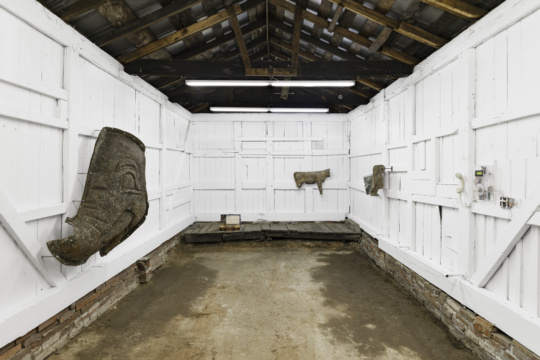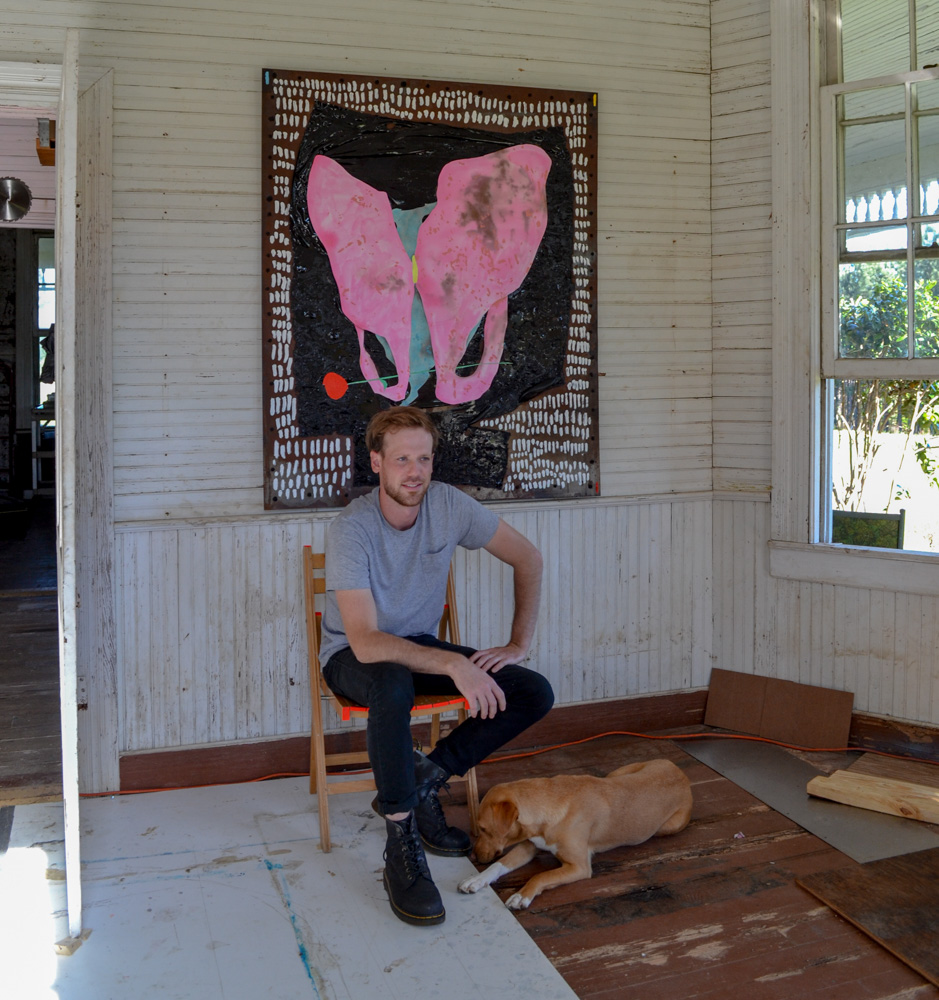
Artist Mark Starling recently moved back to Georgia after graduate school in New Haven and living in New York for several years. He grew up in Harlem, Georgia, above his family’s funeral home, and currently splits his time between Atlanta and an old family house in Warrenton, GA, about a two-hour drive from the city. In 2018, he mounted a solo exhibition at 315 Gallery in Brooklyn showing sculptures of modified casket lids and abstract paintings that relate to calendars. I recently drove out to Mark’s rural studio, where we spoke about his unique upbringing, his recent return to Georgia, and how dealing with themes of accumulation, decay, and metamorphosis are therapeutic for working through the anxieties of making work about death. Our conversation has been edited for publication.
Katya Tepper: Let’s start with this very specific place where your studio is located. How did you end up making art in this very old building deep in rural Georgia after following the more conventional route of getting an MFA at Yale and relocating to Brooklyn?
Mark Starling: My great-great grandfather built this house in 1900. He was a school teacher, and he built houses on the side. My mom grew up in this house, and then my grandparents moved out about fifty years ago, and my grandpa was using it for storage since. Right after finishing my undergrad at University of Georgia, I went to Yale for my MFA, and then moved to New York. I love New York, and it’s been good to me, but after four years I needed more space. I saw my work change based on space limitations. Last year, my lease was ending, and I knew there was an opportunity to use this place as a studio. So my partner and I moved down here last October.
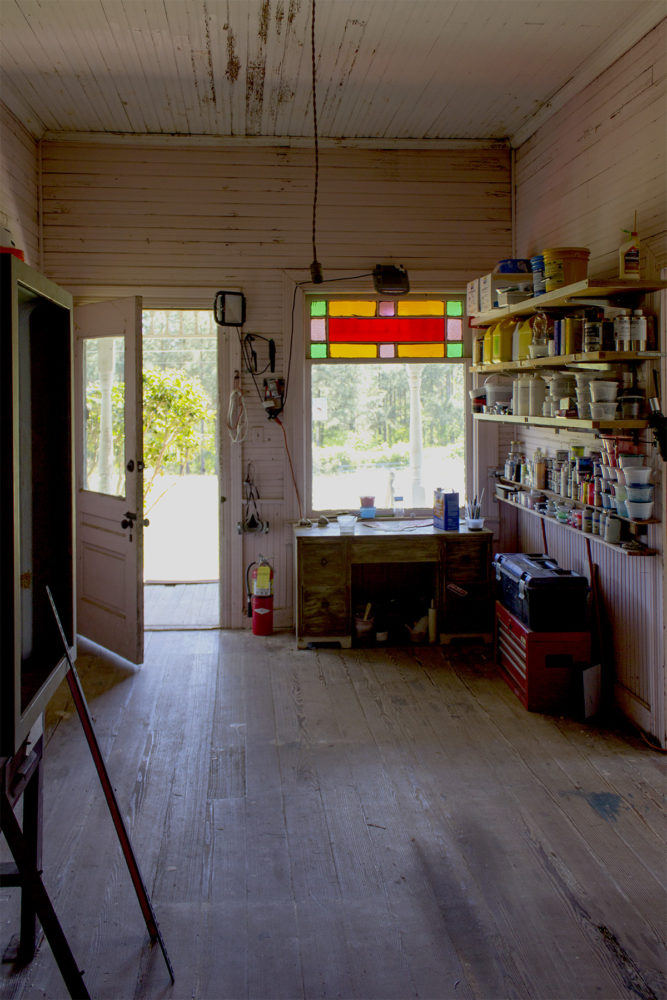
KT: I was under the impression at first that this is actually the funeral home that you grew up in, but can you talk about that?
MS: I grew up about 20 minutes from here. My dad ran a funeral home in Harlem, Georgia. I grew up above it. My dad was a mortician, so I spent a lot of time working on funerals, or just being next to all that while trying to do my own thing. Just like, at two in the morning going with my dad to a residence call, and then going to bed and going to school the next day.
KT: That’s so intense. When did you start making work out of this biographical experience?
MS: I’ve been making drawings that reference my mortality since I was a kid. I keep working through it. For many the funeral home is the beginning of the end, for me it has always been the beginning. Death is something personal that we all think about in our own way. Growing up in a funeral home has conditioned my comfort level around death, though I still have a lot of anxiety and discomfort considering my own mortality. I think making art is the opposite of death.
KT: You’ve been exploring these themes even when living outside of this area where you grew up. How has the energy shifted working on these casket lids in this dilapidated house with all this history, versus when you were making work in Brooklyn surrounded by other artists? Do you feel haunted being really isolated out here?
MS: Yeah, definitely out here there’s a lot of personal history beyond growing up in the funeral business. There’s so much history in these walls from ancestors, and the erosion that’s taken place. It’s really interesting to see this work in relation to these walls, to see 120 years of erosion and decomposition and personal history next to what I’m working on. I’ve been starting to use pecan hull dye and goldenrod, stuff I’m sourcing from this land. When I was growing up here, no one identified as an artist. My grandfather was a farmer, but he would go to Atlanta every week or so, to this place called Peachtree Salvage. He would load up his truck with stuff they didn’t want anymore, and he would organize it here and use it for building and fixing stuff. When we moved back here, this house was still filled with his storage collection, and I’ve been using some of the found objects in my work. This work in progress has a bunch of stuff I found just from being in this house. These stainless steel found objects have a very morgue feel to me. I don’t know if this mirror is cheesy, but I do want to make people look at themselves.
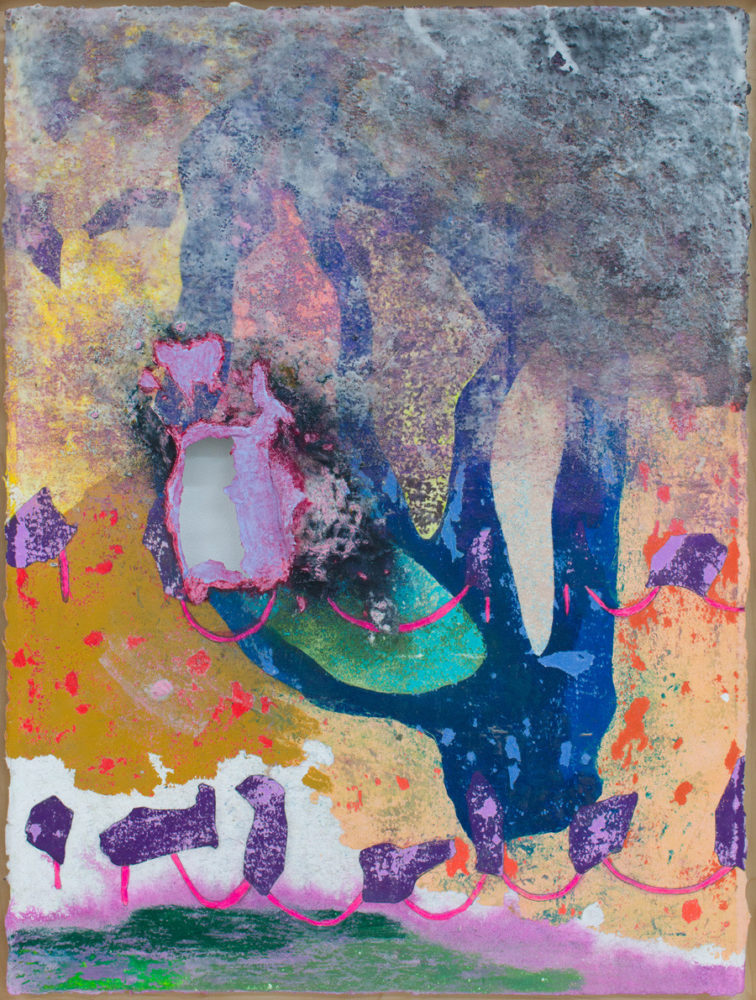
KT: I’m interested in the way you’re incorporating found objects, often beyond recognition. Going through documentation of the show you had last year at 315 Gallery in Brooklyn, there are a lot of materials and processes that are layered together in mysterious ways that the materials list helps to reveal. You often use casket lids, but they are so manipulated. One piece the materials list reads “plastic cast belly button, clay, resin, flocking fiber, polyurethane, oil paint, acrylic paint and mica powder on steel casket lid”. Other pieces describe the work containing remnants of food: Oreo cookies, or pepper flakes. Can you talk about your relationship to this element of supplemental language that surrounds each piece? It reminds me of Robert Gober, who leaves many pieces untitled but the materials list is integral to the understanding of the work.
MS: Some of the material moments come out of experiences that I’ve had directly. Being upstairs in the funeral home eating a spicy sandwich, while someone downstairs is mourning over a lost loved one. I’ve wrestled with many of the seemingly absurd dualities, and it feels good to be able to make some sense of it all. Even if the objects are beyond recognition, I’m open to the the viewer having multiple kinds of experiences with the work. The casket lids come from considering my own mortality, but I think everyone has different comfort levels with thinking about death. I think that funerals are a way to display comfort through presentation. The funeral business is all about presentation.

KT: How does shifting the orientation of the casket lids, having them face outward on the wall, change the relationship to the body/to the viewer’s body?
MS: The idea around the casket lid work came from sleeping directly above the room that displayed caskets. The orientation of my body and my bed in relation to the caskets below was a trip. By placing the casket lids on the wall, the viewer is staring inside the interior of the lid, the same position as someone who is inside a casket when it is closed. It is a sort of confrontation.
KT: How do you source these casket lids?
MS: My dad knows a guy with a casket company. I’m able to just request the lid, and I’ve only gotten steel lids so far. The steel is structural, since I add so much material to them. I’d like to start welding on them as well. I’d like to get some wooden caskets too.
KT: You’re also working on rectangles that I’d say have a more straight relationship to canvas or painting space. But even in the casket work, there’s a rectangular form, and you’re really building out these organic shapes. Can you talk about your relationship to the rectangle versus the more organic shapes that the casket lids take on, mostly as frames for the rectangles?
MS: I’ve been thinking about the casket lid as a support, like a painter uses a canvas. But also, these are very much sculptures, so I have to treat them that way. The material is steel and I like to describe working on them as “modifying” or “extending” them. The extended portion of the lid is carved out of poured polyurethane foam, and its an intuitive process. I pour the foam, carve it, and harden it with resin. Some of the shapes coming off the lids remind me of bones or orifices. I think the way I process materials in the studio, constantly adding and subtracting, destroying and revitalizing objects – this relates to the body and how it functions. I like how it can work on different levels. In some new drawings I’m working on, the pelvic bone has become a character of sorts.

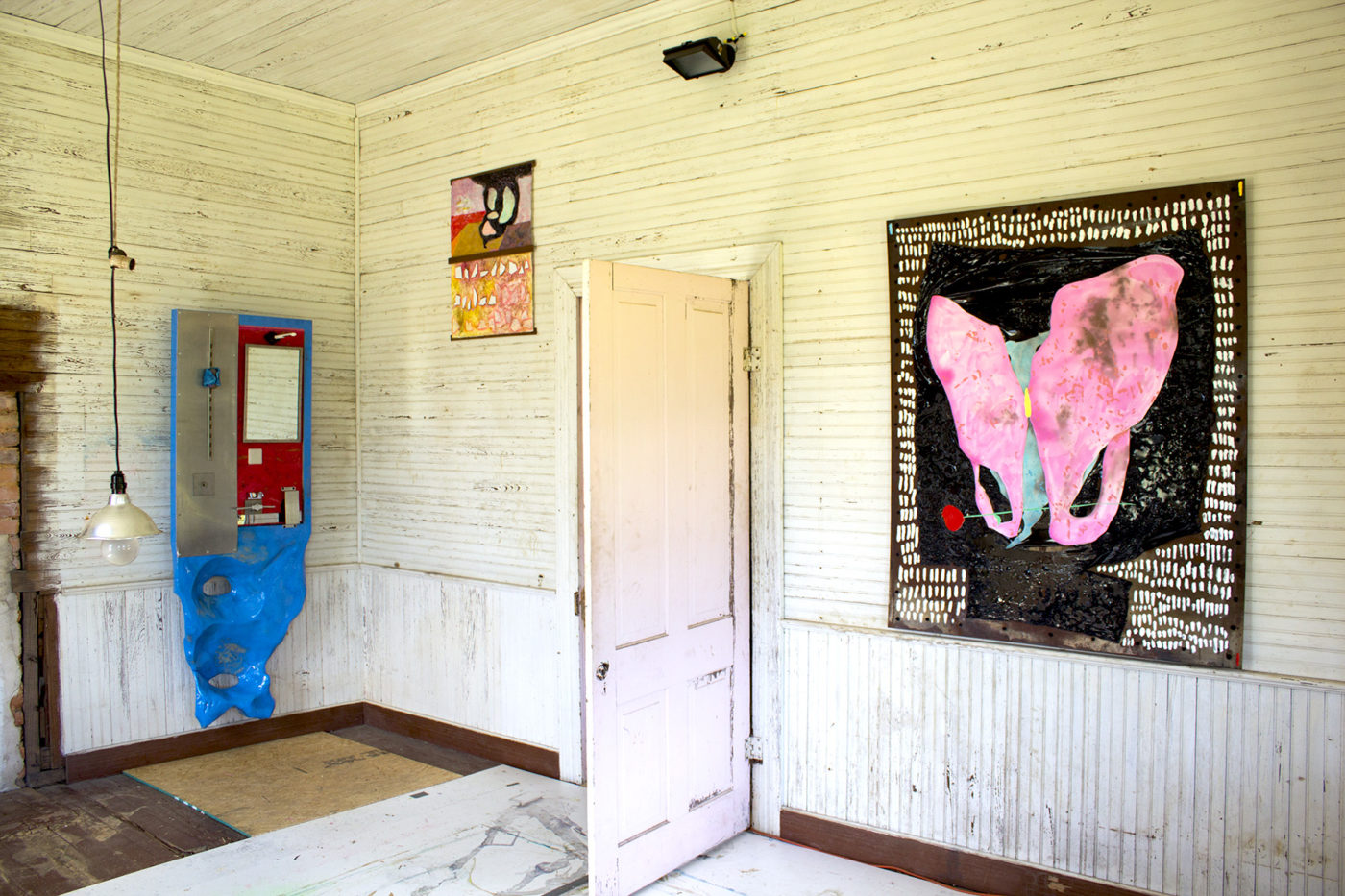
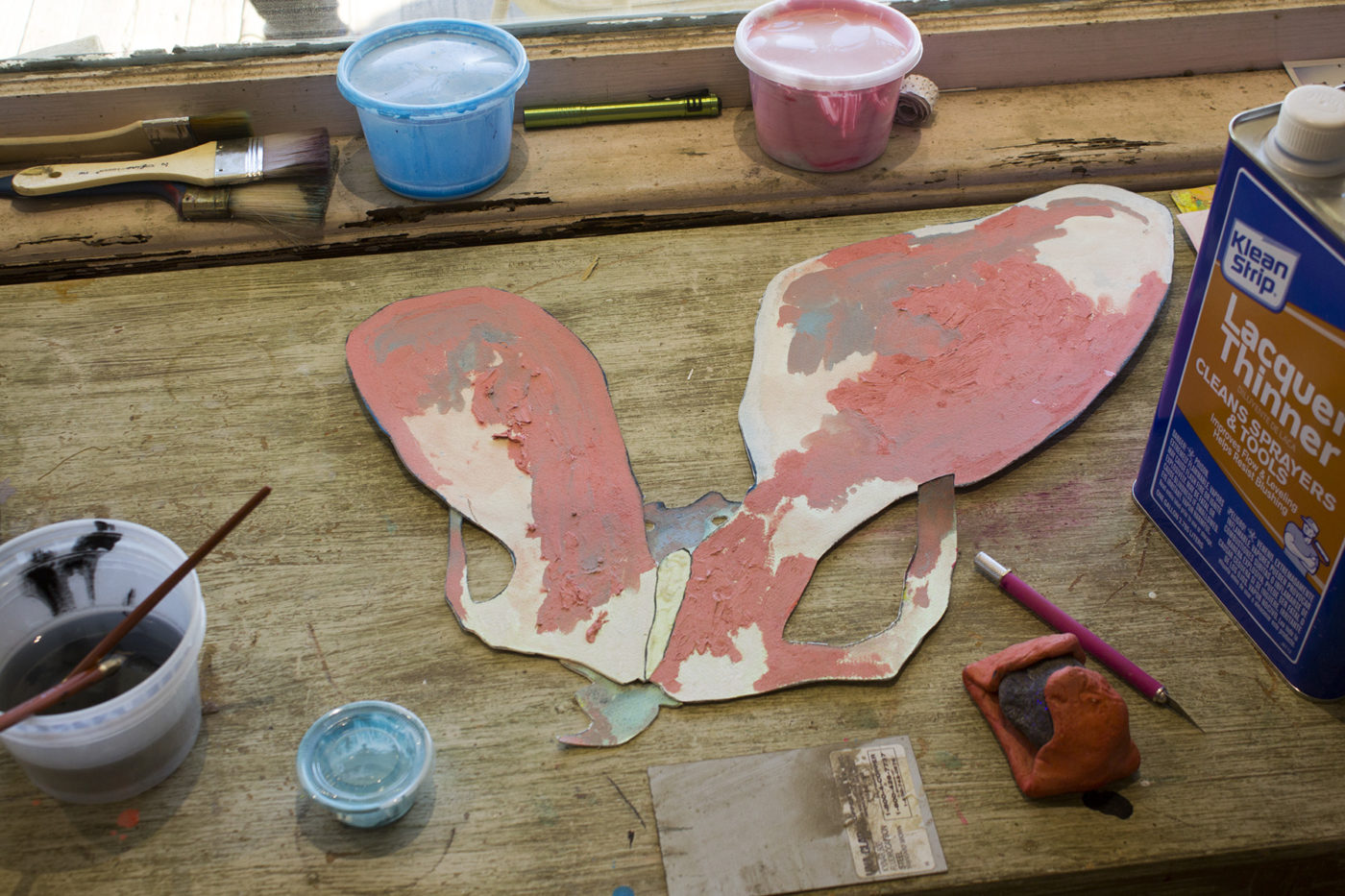
KT: How did you end up coming to this imagery?
MS: I was drawing these other weird figures for a while, with holes in them. The pelvis bone has these two holes that are very much like eyes or a mask, very much looking back at you.
KT: I also think of it as a butterfly. It feels like the idea of metamorphosis is relevant to your work. It sounds like you’re interested in decay not just of the body, but the wood that this house is built with, the decay of everything basically. Decay as a metamorphosis or transformation.
MS: Yeah, and there’s a nastiness to that. I think that’s where a lot of times we need an injection of comfort. There are symbols associated with this kind of comfort, like flowers. I’m interested in incorporating and juxtaposing these comfort symbols like flowers against this pelvic bone image.

KT: There’s also something really nice to me about how the pelvic bone is the site of genitals on the body, but in its skeletal form, it evades these supposed marks of gender. The drawings themselves are also very delicate, sort of decorative with flowers, and the colors feel feminine. How do the drawings relate to your other work? Do these function as their own thing, or are they preparatory for making the sculptures and paintings?
MS: Drawing is a daily ritual for me. Working on paper is an outlet for interpreting or abstracting the figure or the body in a finite landscape. I am incessantly drawing. It’s a huge part of my practice. It’s is so experimental and changing, things could cross over at any moment. I actually covered this hole to this casket lid, and I had a model of a pelvic bone that I forgot was behind it. So it’s kind of lost behind there, and I’m just gonna have to leave it there.
Finding the pelvic bone actually came out of carving one of the sculptures. Things definitely bleed back and forth.
KT: How long do things take to develop? How do you intuit when something is done? It seems like accumulation is such a big part of this process.
MS: Things take a long time to make, besides the drawings on paper. This painting, I’ve placed this figure in this landscape. There are shapes that feel kind of like chips and blocks, where I’m trying to create this aspect of counting, like a calendar system. Or these tick marks in this piece. I’m thinking about a notation for time. How it links and stops. Usually, there’s a deadline, and that stops me. Otherwise, there’s so much back and forth before something is shown, so much adding and subtracting. It’s a very therapeutic for me. If it’s in the studio, it has the possibility to keep changing.
MS: Things take a long time to make, besides the drawings on paper. This painting, I’ve placed this figure in this landscape. There are shapes that feel kind of like chips and blocks, where I’m trying to create this aspect of counting, like a calendar system. Or these tick marks in this piece. I’m thinking about a notation for time. How it links and stops. Usually, there’s a deadline, and that stops me. Otherwise, there’s so much back and forth before something is shown, so much adding and subtracting. It’s a very therapeutic for me. If it’s in the studio, it has the possibility to keep changing.
Mark Starling (b. 1987, Harlem, GA) received his BFA from University of Georgia, Lamar Dodd School of Art, Athens, GA in 2011 and received his MFA from Yale University School of Art, New Haven, CT in 2014. His recent solo shows included Fixed at Atlanta Contemporary and Finish at 315 Gallery.



